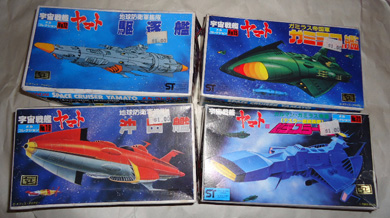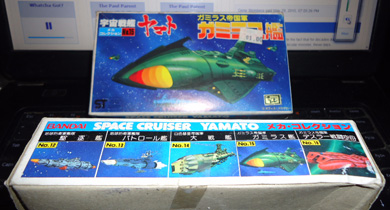 |
|
|||
 |
 |
|||
Copyright © Harry Rinker, LLC 2015 Questions
and Answers
QUESTION: I recently purchased four Bandai Japanese model kits at a garage sale. I paid five dollars for the four kits. The kits, number 12, 15, 19, and 23, are of futuristic space ships. “Bandai Space Cruiser Yamato” is the only English phrase on the box and is located above five illustrations of other numbered space ships in the series on the two longest side panels of each box. My research shows that these are associated with the late 1970s Japanese animated cartoon series “Space Battleship Yamato,” aired in the United States as “Star Blazers.” I found similar examples of the model kits priced between $1.00 and $13.00 on eBay. However, the boxes of the model kits on eBay do not match the examples I have. What do I have? What are the models worth? – BS, Ontario, Canada, Email Question
ANSWER: Research often leads in a number of different directions, some of which result in wonderful new discoveries. In this case, the research threads include a history of Bandai, Japanese anime (animation), and the battleship and space ship “Yamato.” Bandai, the number three producer of toys after Mattel and Hasbro, is best known to American collectors for toy lines such as Astroboy, Gobots, Gundam, Power Rangers, Tomagotchi, Teen Titans, Thundercats, and Ultraman. In 1947, Naoharu Yamashina, a World War II veteran, developed a toy distribution line for his brother-in-law’s textile business. Yamashina assumed control of the toy distribution program in 1950 and named it Bandai. By March 1951, Bandai was importing metal cars and planes globally. By 1953, Bandai had established its Waraku Works, a manufacturing facility, and a new Tokyo headquarters. It opened a New York office in the early 1960s. 1963 saw the launch of Bandai’s Astroboy toy line, its first toy line based on a children’s cartoon. Ultraman followed in 1966. Bandai acquired a plant in Shimizu City in 1969. This plant focused on the manufacture of plastic model toys. In October 1977, Bandai entered into a business relationship with Monogram, an American manufacturer of model kits. Bandai’s Hong Kong manufacturing operation opened in 1977. Noaharu Yamashina’s son Makato assumed control of Bandai in 1980. [Author’s Note: For the purpose of this answer, I am ending the Bandai history in 1980. The company continued to grow and expand. For a detailed history of Bandai, see: http://www.fundinguniverse.com/company-histories/bandai-co-ltd-history/ and http://en.wikipedia.org/wiki/Bandai] “Space Battleship Yamato” (Space Cruiser Yamato), an animated cartoon series developed by producer Yoshinobu Nishizaki, first aired in Japan on October 6, 1974. Set in the year 2199, the first season featured the “Gamilas” (“Gamilons’ in English), whose radioactive meteorite bombs made Earth’s surface life uninhabitable. A massive space ship, featuring space warp drive and the wave motion gun, is built inside the ruins of the World War II Japanese battleship “Yamato.”
Since its inception, 10 additional cartoon series and two live action remakes have been made. The “Space Battleship Yamato” enjoyed global distribution. Its Australian and North American version known as “Star Blazer,” featuring the 1973, 1978, and 1980 series, was first broadcast in 1979. [See: http://en.wikipedia.org/wiki/Space_Battleship_Yamato and http://en.wikipedia.org/wiki/Star_Blazers] As a result of Bandai’s failure to secure the rights to the Super Car boom, Bandai’s Shizuoka prefecture factory was closed and operations moved to the Tochigi Bandai Plant. Bandai marketed its first four “Space Battleship” Yamato model kits – Yamato, Cosmo Zero, Black Tiger, and Analyzer Robot – in 1977. They enjoyed a modest success. Continually refining the line, Bandai launched its 100-yen (approximately 1 US dollar at the time) Mecha Collection series in 1979. There were 30 kits in the series. The scale was not uniform. Assembly instructions were printed inside the box, made from recycled material, to save on paper. Ink colors were limited to three – red, blue, and yellow. Black was missing. Production of the first edition of the Mecha Collection continued until June 1981. [See: http://ourstarblazers.com/vault/158/, http://ourstarblazers.com/vault/159/, http://ourstarblazers.com/vault/161/, and http://ourstarblazers.com/vault/167/.] The four kits you purchased are part of the Mecha Collection – No. 12, EDF Destroyer: No. 15, Gamilas Destroyer with mini space submarine: No. 19, Captain Okita’s Battleship with Cosmo Zero; and No. 23, New Dressler Battleship. The difference between your boxes and those of the identical models you found on eBay is simple. Your kits date from the late 1970s and early 1980s. The model kits on eBay are later issues, using the same models. Most date from the 21st century, some in current production. Your kits are “first edition” kits. I have not been able to find any comparable pricing for your model kits. Among the possibilities are: (1) they were purchased in Japan and brought back to North America or (2) they only received distribution in Canada. For the moment, my advice is to do more research before selling the kits. Given my failure to find comparables, their scarcity appears high. Be careful in rushing to judgment on this issue. Also, the best secondary market may be Japan rather than the United States. Posting them for sale on eBay.com or eBay.ca may not result in reaching the best group of competitive bidders. Given the popularity of the cartoon series and the retail price of the existing model kits, most likely made from the same production molds as the 1979/1980 kits, a conservative secondary price for each of your model kits is between $25.00 and $30.00. If my guess is correct, additional research will reveal that these numbers are low – very low. QUESTION: In going through my ham radio material, I recently discovered a large batch of QSL cards dating from the last decades of the 20th century. They are of no use to me. Do they have any value? – H, West Chester, PA ANSWER: During the mid-1980s, I had a brief encounter with amateur radio. I was WN3MWU and had my own QSL cards printed. Unfortunately, my sense of pitch did not allow me to differentiate code fast enough to qualify for my full license. My pile of QSL cards has vanished. I continue to hope someday to find them in a storage box of my high school material. QSL cards, usually postcard size, are used by amateur radio operator to confirm the reception of a signal or as a one-way recognition for receiving a signal from a broadcast source such as AM, FM, or shortwave radio or television. QSL? means “do you confirm receipt of my transmission.” QSL is the confirmation code. The earliest QSL card dates to 1916. Amateur radio quickly adopted the procedure. While the information – band, mode of transmission, contact, date, and time – remain fixed, the surface image is restricted only to the creativity of the sender. Although collected, QSL cards have minimal value. Outside the secondary postcard market place, the standard asking price is between ten and fifty cents. Even in the secondary postcard market, prices in the $1.00 to $2.00 range are typical. Bill Judnick’s article on QSL cards [http://www.judnick.com/judnick/QSLValues.htm] contains a brief history of the QSL cards and a detailed list of value added criteria. Criteria include country of origin, location (big city versus small town or rural area), condition, artwork, use of colors, and date. If you know of an enthusiastic young amateur radio operator in your area, offer them to him/her as a means of encouraging interest in the hobby. Living in the greater Philadelphia area, there are several specialized postcard and paper ephemera shows. Visit one of them, take your QSL cards along, and take the best price offered. QUESTION: I have an opalescent green glass footed bowl. It has no manufacturer’s markings. It is 9 inches in diameter and stands 3 inches high. The top edge is crimped, similar to that of a pie. The pattern is three pedaled flowers separated by a motif featuring four interlocking circles. Can you identify the manufacturer, time period, pattern, and value? – JK, Allentown, PA, Email Question.
ANSWER: I sent the illustration that accompanied your email to Debbie and Randy Coe, authors of “Elegant Glass: Early, Depression, & Beyond” published by Schiffer Publishing. The Coes identified your bowl as Northwood’s Ruffle & Rings pattern, first manufactured in 1905. Harry Northwood, son of John Northwood, a pioneer in the English glass industry, immigrated to the United States in 1881. He worked for a number of American glass firms including Hobbs, Brockunier & Company, LaBelle Glass Works, and Phoenix Glass Company. While working at LaBelle in 1886, Northwood helped introduce opalescent crimped glassware. After a fire destroyed LaBelle in the fall of 1887, Northwood established the Northwood Glass Company in 1888. Originally located in Martin’s Ferry, Ohio, it moved to Elwood, Pennsylvania in 1892 and Indiana, Pennsylvania in 1896. A series of reorganizations eventually resulted in H. Northwood and Company. Harry Northwood died in 1919. The Ruffles and Rings pattern was manufactured in a variety of rim shapes – crimped, scalloped, and flared square. Colors also varied. Your Ruffles and Rings opalescent green bowl is common. Its secondary market price is between $40.00 and $50.00.Harry L. Rinker welcomes questions from readers about
collectibles, those mass-produced items from the twentieth and twenty-first centuries.
Selected letters will be answered in this column.
Harry cannot provide personal answers.
Photos and other material submitted cannot be
returned.
Send your questions to: Rinker on Collectibles, 5955 Mill
Point Court SE, Kentwood, MI 49512.
You also can e-mail your questions to
harrylrinker@aol.com.
Only e-mails containing a full name and mailing address
will be considered.
You can listen
and participate in
WHATCHA GOT?, Harry’s
antiques and collectibles radio call-in show, on Sunday mornings between 8:00 AM
and 10:00 AM Eastern Time.
If you
cannot find it on a station in your area,
WHATCHA GOT?
streams live on the Internet at www.gcnlive.com.
SELL, KEEP OR TOSS?: HOW TO DOWNSIZE A HOME,
SETTLE AN ESTATE, AND APPRAISE PERSONAL PROPERTY
(House of Collectibles, an imprint of Random House Information Group, $17.99),
Harry’s latest book, is available at your favorite bookstore and via
www.harryrinker.com.
|
||||


